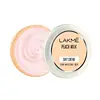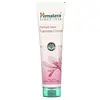What's inside
What's inside
 Key Ingredients
Key Ingredients

 Benefits
Benefits

 Concerns
Concerns

 Ingredients Side-by-side
Ingredients Side-by-side

Water
Skin ConditioningCyclopentasiloxane
EmollientSorbitol
HumectantCaprylic/Capric Triglyceride
MaskingStearic Acid
CleansingHelianthus Annuus Seed Oil
EmollientIsohexadecane
EmollientGlycol Stearate
EmollientDimethicone
EmollientTriethanolamine
BufferingSodium Acrylate/Sodium Acryloyldimethyl Taurate Copolymer
Emulsion StabilisingGlyceryl Stearate
EmollientPhenoxyethanol
PreservativeParfum
MaskingCetyl Alcohol
EmollientMethylparaben
PreservativeCarbomer
Emulsion StabilisingTitanium Dioxide
Cosmetic ColorantDimethiconol
EmollientPolysorbate 80
EmulsifyingTocopheryl Acetate
AntioxidantPropylparaben
PreservativeXanthan Gum
EmulsifyingDisodium EDTA
BHT
AntioxidantPrunus Persica Fruit Extract
AbrasiveStearamide Amp
Linalool
PerfumingButylphenyl Methylpropional
PerfumingAlpha-Isomethyl Ionone
PerfumingCitronellol
PerfumingCI 14700
Cosmetic ColorantWater, Cyclopentasiloxane, Sorbitol, Caprylic/Capric Triglyceride, Stearic Acid, Helianthus Annuus Seed Oil, Isohexadecane, Glycol Stearate, Dimethicone, Triethanolamine, Sodium Acrylate/Sodium Acryloyldimethyl Taurate Copolymer, Glyceryl Stearate, Phenoxyethanol, Parfum, Cetyl Alcohol, Methylparaben, Carbomer, Titanium Dioxide, Dimethiconol, Polysorbate 80, Tocopheryl Acetate, Propylparaben, Xanthan Gum, Disodium EDTA, BHT, Prunus Persica Fruit Extract, Stearamide Amp, Linalool, Butylphenyl Methylpropional, Alpha-Isomethyl Ionone, Citronellol, CI 14700
Water
Skin ConditioningStearic Acid
CleansingEthylhexyl Methoxycinnamate
UV AbsorberGlycerin
HumectantIsopropyl Myristate
EmollientNiacinamide
SmoothingParfum
MaskingPotassium Hydroxide
BufferingPhenoxyethanol
PreservativeMethylisothiazolinone
PreservativeCetyl Alcohol
EmollientCoco-Caprylate/Caprate
EmollientButyl Methoxydibenzoylmethane
UV AbsorberCrocus Sativus Flower Extract
MaskingCaprylic/Capric/Stearic Triglyceride
Skin ConditioningAcrylates/C10-30 Alkyl Acrylate Crosspolymer
Emulsion StabilisingDisodium EDTA
Tocopheryl Acetate
AntioxidantMedicago Sativa Extract
TonicCI 47005
Cosmetic ColorantWater, Stearic Acid, Ethylhexyl Methoxycinnamate, Glycerin, Isopropyl Myristate, Niacinamide, Parfum, Potassium Hydroxide, Phenoxyethanol, Methylisothiazolinone, Cetyl Alcohol, Coco-Caprylate/Caprate, Butyl Methoxydibenzoylmethane, Crocus Sativus Flower Extract, Caprylic/Capric/Stearic Triglyceride, Acrylates/C10-30 Alkyl Acrylate Crosspolymer, Disodium EDTA, Tocopheryl Acetate, Medicago Sativa Extract, CI 47005
Ingredients Explained
These ingredients are found in both products.
Ingredients higher up in an ingredient list are typically present in a larger amount.
Cetyl Alcohol is a fatty alcohol. Fatty Alcohols are most often used as an emollient or to thicken a product.
Its main roles are:
Though it has "alcohol" in the name, it is not related to denatured alcohol or ethyl alcohol.
The FDA allows products labeled "alcohol-free" to have fatty alcohols.
Learn more about Cetyl AlcoholDisodium EDTA plays a role in making products more stable by aiding other preservatives.
It is a chelating agent, meaning it neutralizes metal ions that may be found in a product.
Disodium EDTA is a salt of edetic acid and is found to be safe in cosmetic ingredients.
Learn more about Disodium EDTAParfum is a catch-all term for an ingredient or more that is used to give a scent to products.
Also called "fragrance", this ingredient can be a blend of hundreds of chemicals or plant oils. This means every product with "fragrance" or "parfum" in the ingredients list is a different mixture.
For instance, Habanolide is a proprietary trade name for a specific aroma chemical. When used as a fragrance ingredient in cosmetics, most aroma chemicals fall under the broad labeling category of “FRAGRANCE” or “PARFUM” according to EU and US regulations.
The term 'parfum' or 'fragrance' is not regulated in many countries. In many cases, it is up to the brand to define this term.
For instance, many brands choose to label themselves as "fragrance-free" because they are not using synthetic fragrances. However, their products may still contain ingredients such as essential oils that are considered a fragrance by INCI standards.
One example is Calendula flower extract. Calendula is an essential oil that still imparts a scent or 'fragrance'.
Depending on the blend, the ingredients in the mixture can cause allergies and sensitivities on the skin. Some ingredients that are known EU allergens include linalool and citronellol.
Parfum can also be used to mask or cover an unpleasant scent.
The bottom line is: not all fragrances/parfum/ingredients are created equally. If you are worried about fragrances, we recommend taking a closer look at an ingredient. And of course, we always recommend speaking with a professional.
Learn more about ParfumPhenoxyethanol is a preservative that has germicide, antimicrobial, and aromatic properties. Studies show that phenoxyethanol can prevent microbial growth. By itself, it has a scent that is similar to that of a rose.
It's often used in formulations along with Caprylyl Glycol to preserve the shelf life of products.
Stearic Acid is a fatty acid. It is an emollient, emulsifier, and texture enhancer.
As an emollient, stearic acid helps soften skin. It aids the skin's protective barrier by preventing water loss. It also provides a gentle cleansing effect without stripping away natural oils.
Stearic acid may also be used to enhance the texture of products. It can add volume and stabilize ingredients such as water and oil. This can help water and oil ingredients from separating.
Sources of stearic acid include animal or vegetable fats/oils such as coconut or shea. It can be naturally found in butter, cocoa butter, shea butter, vegetable fats, and animal tallow.
This ingredient may not be Malassezia folliculitis, or fungal-acne safe.
Learn more about Stearic AcidTocopheryl Acetate is AKA Vitamin E. It is an antioxidant and protects your skin from free radicals. Free radicals damage the skin by breaking down collagen.
One study found using Tocopheryl Acetate with Vitamin C decreased the number of sunburned cells.
Tocopheryl Acetate is commonly found in both skincare and dietary supplements.
Learn more about Tocopheryl AcetateWater. It's the most common cosmetic ingredient of all. You'll usually see it at the top of ingredient lists, meaning that it makes up the largest part of the product.
So why is it so popular? Water most often acts as a solvent - this means that it helps dissolve other ingredients into the formulation.
You'll also recognize water as that liquid we all need to stay alive. If you see this, drink a glass of water. Stay hydrated!
Learn more about Water